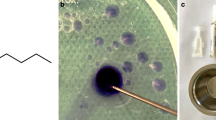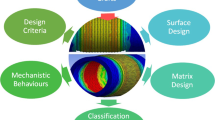Abstract
Permanent selective occlusion by detachable balloons with parent vessel preservation is considered to be the endovascular treatment of choice of intracranial aneurysms. It has been proposed that replacement of contrast material within the balloon with a polymerizing substance will eliminate balloon deflation. Despite this solution, our clinical experience with polyisoprene rubber balloons shows that deflation can still occur when the balloons are filled with poly(2-hydroxyethyl methacrylate). Experimental data are presented that demonstrate the chemical incompatibility between hydroxyethyl methacrylate (HEMA) and polyisoprene rubber. The resulting degradation of the polyisoprene rubber accounts well for balloon failure. Thein vitro behaviour of silicone balloons and of a new HEMA sponge formulation to fill the balloons are compared.
Similar content being viewed by others
References
G. DEBRUN, P. LACOUR, J. P. CARON, M. HURTH, J. COMOY and Y. KERAVEL,J. Neurosurg. 49 (1978) 635.
G. B. HIESHIMA, R. T. HIGASHIDA, V. V. HALBACH, L. CAHAN and K. GOTO,AJNR 7 (1986) 916.
F. A. SERBINENKO,J. Neurosurg. 41 (1974) 125.
K. GOTO, V. V. HALBACH, C. W. HARDIN, R. T. HIGASHIDA and G. B. HIESHIMA,Radiology 169 (1988) 787.
W. TAKI, H. HANDA, S. YAMAGATA, M. ISHIKAWA, H. IWATA and Y. IKADA,Surgical Neurol. 13 (1980) 140.
M. BARVIC, K. KLIMENT and M. ZAVADIC,J. Biomed. Mater. Res. 1 (1967) 313.
R. A. HALDON and B. E. LEE,Br. Polym. J. 4 (1972) 491.
D. HORAK, F. SVEC and J. KALAL,Biomater. 7 (1986) 188.
N. A. PEPPAS and H. J. MOYNIHAN, in “Hydrogels in Medicine and Pharmacy”, edited by N. A. Peppas, (CRC, Boca Raton, 1987) pp. 49–64.
J. J. MERLAND and D. RUFFENACHT, in “Neuroradiology”, edited by J. Valk (Elsevier Science, Amsterdam 1985) pp. 291–294.
G. B. HIESHIMA, V. S. GRINNEL and C. M. MEHRINGER,Radiology 138 (1981) 227.
G. V. O'RELILLY, J. KLEEFIELD, M. D. FORREST, P. A. SVENDSEN and J. R. SERUR,AJNR 5 (1984) 625.
Author information
Authors and Affiliations
Rights and permissions
About this article
Cite this article
Nonent, M., Laurent, A., Merland, J.J. et al. Chemical incompatibility between polymerizing HEMA and rubber balloons used for selective endovascular treatment of intracranial aneurysms. J Mater Sci: Mater Med 2, 89–93 (1991). https://doi.org/10.1007/BF00703465
Received:
Accepted:
Issue Date:
DOI: https://doi.org/10.1007/BF00703465




